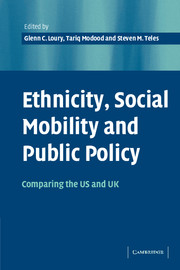Book contents
Introduction
Published online by Cambridge University Press: 22 September 2009
Summary
Edited volumes are, by their very nature, a compilation of the views of different minds. And yet, in most cases, those different minds are chosen for a purpose. In the case at hand that purpose can be intuited from the title of this volume: Ethnicity, Social Mobility, and Public Policy: Comparing the USA and UK. The assumptions underlying the editors' efforts in bringing these many scholars together are essentially twofold: that social mobility is a heterogeneous phenomenon – not functioning the same way in every society and for every social group; and, that the social markers of ethnicity and race matter in the study of social mobility. Ethnicity and race are causally related to social mobility for the obvious reason that actors in society at large distribute mobility – relevant goods with those markers in mind, but also because those markers represent real social formations in the context of which mobility-relevant goods are produced and nurtured. Our view is that, in discerning how these effects play themselves out, analytical leverage is gained by making reference to the broadest possible range of groups and social settings. This we attempt to do in this volume. This introductory essay will elaborate on and defend these assumptions, and then connect them to the structure and content of the book.
Social mobility – what is it?
The editors of this volume view social mobility not as a single, homogeneous phenomenon, but rather as a cluster of interdependent social processes.
- Type
- Chapter
- Information
- Ethnicity, Social Mobility, and Public PolicyComparing the USA and UK, pp. 1 - 18Publisher: Cambridge University PressPrint publication year: 2005
References
- 5
- Cited by

